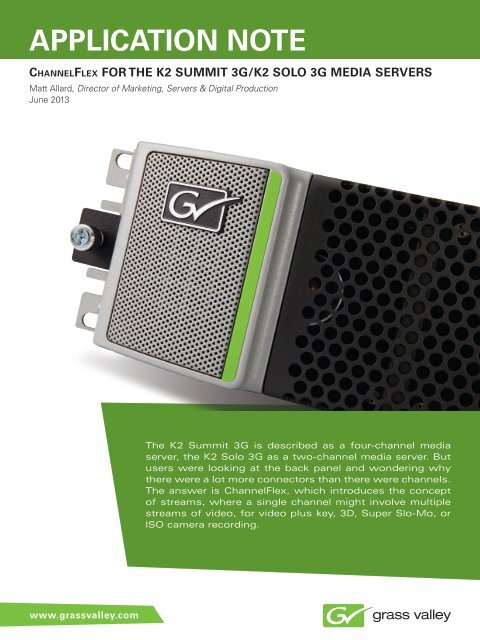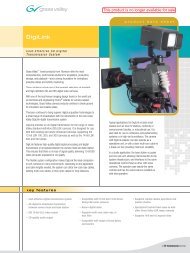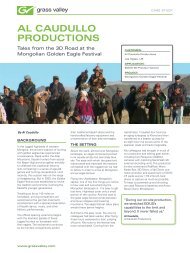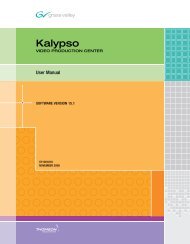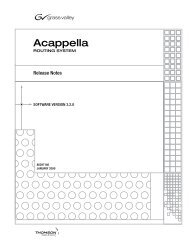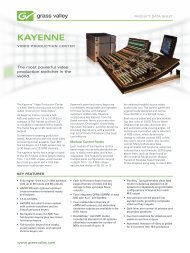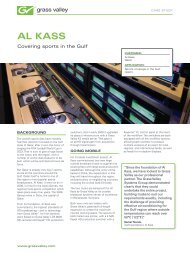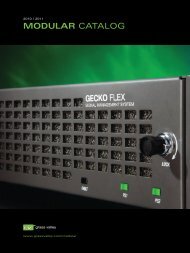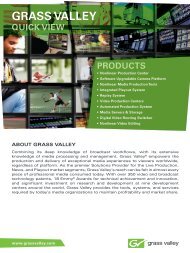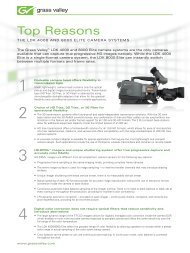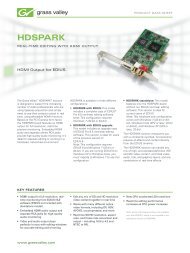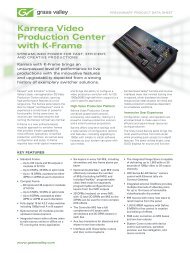ChannelFlex for the K2 Summit 3G/K2 Solo 3G Media ... - Grass Valley
ChannelFlex for the K2 Summit 3G/K2 Solo 3G Media ... - Grass Valley
ChannelFlex for the K2 Summit 3G/K2 Solo 3G Media ... - Grass Valley
You also want an ePaper? Increase the reach of your titles
YUMPU automatically turns print PDFs into web optimized ePapers that Google loves.
APPLICATION NOTE<br />
<strong>ChannelFlex</strong> FOR THE <strong>K2</strong> SUMMIT <strong>3G</strong>/<strong>K2</strong> SOLO <strong>3G</strong> MEDIA SERVERS<br />
Matt Allard, Director of Marketing, Servers & Digital Production<br />
June 2013<br />
The <strong>K2</strong> <strong>Summit</strong> <strong>3G</strong> is described as a four-channel media<br />
server, <strong>the</strong> <strong>K2</strong> <strong>Solo</strong> <strong>3G</strong> as a two-channel media server. But<br />
users were looking at <strong>the</strong> back panel and wondering why<br />
<strong>the</strong>re were a lot more connectors than <strong>the</strong>re were channels.<br />
The answer is <strong>ChannelFlex</strong>, which introduces <strong>the</strong> concept<br />
of streams, where a single channel might involve multiple<br />
streams of video, <strong>for</strong> video plus key, 3D, Super Slo-Mo, or<br />
ISO camera recording.<br />
www.grassvalley.com
<strong>ChannelFlex</strong> FOR THE <strong>K2</strong> SUMMIT <strong>3G</strong>/<strong>K2</strong> SOLO <strong>3G</strong> MEDIA SERVERS<br />
CONTENTS<br />
Introduction 1<br />
What is a “Standard” <strong>K2</strong> <strong>Summit</strong> <strong>3G</strong> Channel? 1<br />
<strong>ChannelFlex</strong>: The Basics 3<br />
3D/Video+Key Recorder Mode 3<br />
3D/Video+Key Player Mode 5<br />
Multicam Recorder Mode 6<br />
Super Slo-Mo Recorder Mode 8<br />
Key things to remember when you’re selecting any of <strong>the</strong> <strong>ChannelFlex</strong> modes 9<br />
Appendix A – Supported Configurations 10<br />
Appendix B – <strong>K2</strong> AppCenter Feature Comparison Chart 11<br />
Appendix C – <strong>ChannelFlex</strong> Summary 12<br />
www.grassvalley.com
<strong>ChannelFlex</strong> FOR THE <strong>K2</strong> SUMMIT <strong>3G</strong>/<strong>K2</strong> SOLO <strong>3G</strong> MEDIA SERVERS<br />
INTRODUCTION<br />
The original design of <strong>the</strong> <strong>K2</strong> <strong>Summit</strong> ® media server plat<strong>for</strong>m was<br />
to support <strong>the</strong> needs of live and studio production environments.<br />
One of <strong>the</strong> key concepts was redefining a “server channel” to better<br />
meet user requirements. The initial product release of <strong>K2</strong> <strong>Summit</strong><br />
implemented a traditional concept of a channel being a simple single<br />
video stream, audio tracks, timecode, and ancillary data, but it was<br />
apparent from <strong>the</strong> <strong>K2</strong> <strong>Summit</strong> rear panel (Figure 1) that much more<br />
was planned. Users would ask: “Why are <strong>the</strong>re three inputs and two<br />
outputs on each channel?”<br />
With <strong>the</strong> release of software version 7.2 and optional <strong>K2</strong> AppCenter<br />
Elite software license, a new set of channel configurations that we call<br />
<strong>ChannelFlex</strong> ® have been enabled. <strong>ChannelFlex</strong> brings <strong>the</strong> capability to<br />
record signals from two and three times frame rate cameras, record<br />
and playback of video plus key, or 3D (left-eye and right-eye), and to<br />
record two camera ISOs all with a single <strong>K2</strong> <strong>Summit</strong> <strong>3G</strong> or <strong>K2</strong> <strong>Solo</strong> ®<br />
<strong>3G</strong> channel.<br />
<strong>ChannelFlex</strong> brings significant flexibility, but <strong>the</strong>re are limitations<br />
so care must be taken to ensure that plat<strong>for</strong>m resources are not<br />
over-subscribed. This application note will explain how all this new<br />
functionality works and rules <strong>for</strong> configuration in <strong>the</strong> context of our<br />
supported applications.<br />
Figure 1 – <strong>K2</strong> <strong>Summit</strong> rear panel.<br />
WHAT IS A “STANDARD” <strong>K2</strong> SUMMIT <strong>3G</strong> CHANNEL?<br />
A “standard” channel is bi-directional (can quickly be programmatically changed between record and play back) and includes a single video<br />
stream, up to 16 audio tracks, a timecode track, and an ancillary data track. If <strong>K2</strong> AppCenter Pro is licensed, <strong>the</strong>n <strong>the</strong> SDI Out2 can be selected<br />
to display superimposed in<strong>for</strong>mation over <strong>the</strong> video (such as timecode, clip name, audio activity monitors, etc.). Figure 2 highlights <strong>the</strong><br />
connectors that are operational during record and play back. There is a single control (RS-422 or E<strong>the</strong>rnet) and a single LTC connection <strong>for</strong> each<br />
channel. Audio is selected from ei<strong>the</strong>r AES (8 tracks/4 AES pairs) or embedded (16 tracks/8 AES pairs).<br />
E- E output<br />
“Super” output<br />
Video input<br />
LTC input<br />
Video input<br />
LTC input<br />
AES audio inputs<br />
RS-422 control<br />
AES audio inputs<br />
RS-422 control<br />
Record<br />
Play<br />
Figure 2 – ”Standard” <strong>K2</strong> <strong>Summit</strong> Channel I/O connection.<br />
www.grassvalley.com
<strong>K2</strong> SUMMIT <strong>3G</strong><br />
PRODUCTION SERVER<br />
WHAT IS A “STANDARD” <strong>K2</strong> SUMMIT <strong>3G</strong> CHANNEL? (CONT.)<br />
<strong>ChannelFlex</strong> FOR THE <strong>K2</strong> SUMMIT <strong>3G</strong>/<strong>K2</strong> SOLO <strong>3G</strong> MEDIA SERVERS<br />
The structure of <strong>the</strong> clip shown in Figure 3 is easily recognizable as a group of essence files: video, audio, timecode, and data each with a<br />
corresponding indexing file, xml reference file <strong>for</strong> <strong>the</strong> clip that provides <strong>the</strong> association of <strong>the</strong> essence files, and a jpeg thumbnail file (keyframe<br />
still image). If <strong>the</strong> compression type is one supported by Apple QuickTime, <strong>the</strong>n a QuickTime reference file is also present to be used by editors<br />
such as Final Cut Pro.<br />
Video<br />
Standard_clip.cmf<br />
Figure 3 – A “Standard” Clip<br />
Figure 3 – A “Standard” clip.<br />
The Properties view in <strong>K2</strong> AppCenter gives more user-friendly views of <strong>the</strong> clip in<strong>for</strong>mation and allows <strong>for</strong> some ability to manipulate tracks and<br />
alter or enter clip in<strong>for</strong>mation (such as aspect ratio).<br />
Figure 4 – “Standard” clip properties.<br />
www.grassvalley.com
<strong>ChannelFlex</strong> FOR THE <strong>K2</strong> SUMMIT <strong>3G</strong>/<strong>K2</strong> SOLO <strong>3G</strong> MEDIA SERVERS<br />
<strong>ChannelFlex</strong>: THE BASICS<br />
<strong>ChannelFlex</strong> is sold as part of <strong>the</strong> <strong>K2</strong> AppCenter Elite application suite (see feature comparison chart in Appendix A) which can be purchased<br />
as a software option to <strong>K2</strong> <strong>Summit</strong> <strong>3G</strong> and <strong>K2</strong> <strong>Solo</strong> <strong>3G</strong> or is included in <strong>the</strong> <strong>K2</strong> Dyno ® S and Elite packages, <strong>the</strong> <strong>K2</strong> <strong>Solo</strong> <strong>3G</strong> Elite, and in <strong>the</strong><br />
Kayenne ® ClipStore. It adds four new channel modes: 3D / Video + Key recorder, 3D / Video + Key player, Multicam recorder, and Super Slo-Mo<br />
Recorder (SSM) which is selectable <strong>for</strong> ei<strong>the</strong>r 2X or 3X speed. These new channel modes are selectable on a channel-by-channel basis through<br />
<strong>the</strong> configuration menu of <strong>K2</strong> AppCenter Elite as shown in Figure 5.<br />
Figure 5 – New <strong>ChannelFlex</strong> configuration screen.<br />
3D/VIDEO+KEY RECORDER MODE<br />
3D/Video+Key Recorder mode configures a <strong>K2</strong> <strong>Summit</strong> <strong>3G</strong> or <strong>K2</strong> <strong>Solo</strong> <strong>3G</strong> channel into a dual video stream recorder that creates a single clip<br />
with two video tracks. When this mode is selected <strong>the</strong>re is a status indication provided <strong>for</strong> video input present on both <strong>the</strong> SDI IN1 and SDI<br />
IN2 inputs <strong>for</strong> <strong>the</strong> channel (see Figure 6). Along with <strong>the</strong> video streams, audio, timecode, and ancillary date are also recorded if selected. Up<br />
to eight audio tracks can be recorded from ei<strong>the</strong>r <strong>the</strong> AES/EBU inputs or from <strong>the</strong> embedded audio on <strong>the</strong> SDI IN1 input as shown in Figure 7.<br />
In Figure 8 you can see <strong>the</strong> physical connections used in this mode. It should be noted that <strong>the</strong> output SDI OUT1 and SDI OUT 2 provide E-E<br />
monitor outs of <strong>the</strong> respective inputs. Regardless of whe<strong>the</strong>r <strong>the</strong> inputs have left-eye and right-eye signals or video plus associated key signal<br />
from a graphics device, <strong>the</strong> resulting clip creates <strong>the</strong> same set of files as shown in Figure 9.<br />
Figure 6 – 3D/Video+Key Recorder mode configuration screen.<br />
www.grassvalley.com
<strong>K2</strong> SUMMIT <strong>3G</strong><br />
PRODUCTION SERVER<br />
3D/VIDEO+KEY RECORDER MODE (CONT.)<br />
<strong>ChannelFlex</strong> FOR THE <strong>K2</strong> SUMMIT <strong>3G</strong>/<strong>K2</strong> SOLO <strong>3G</strong> MEDIA SERVERS<br />
Figure 7 – 3D/Video+Key Recorder audio selections.<br />
L-Eye<br />
E-to-E<br />
R-Eye<br />
E-to-E<br />
Key<br />
Key E-to-E<br />
L-Eye<br />
R-Eye<br />
LTC input<br />
Video<br />
Video E-to-E<br />
LTC input<br />
AES audio inputs<br />
RS-422 control<br />
AES audio inputs<br />
RS-422 control<br />
Figure 8 – 3D/Video+Key Recorder audio selections.<br />
Right Eye<br />
Left Eye<br />
3D_V+K_clip.cmf<br />
Figure 9 – A 3D/Video+Key clip.<br />
www.grassvalley.com
<strong>ChannelFlex</strong> FOR THE <strong>K2</strong> SUMMIT <strong>3G</strong>/<strong>K2</strong> SOLO <strong>3G</strong> MEDIA SERVERS<br />
3D/VIDEO+KEY PLAYER MODE<br />
3D/Video+Key Player mode configures a <strong>K2</strong> <strong>Summit</strong> <strong>3G</strong> or <strong>K2</strong> <strong>Solo</strong> <strong>3G</strong> channel into a dual video stream player. If a 3D/Video+Key clip is loaded<br />
into <strong>the</strong> channel, <strong>the</strong>n SDI OUT1 will play <strong>the</strong> video.f0 file (originally recorded on SDI IN1) and SDI OUT2 will play <strong>the</strong> video.f1 (originally<br />
recorded from SDI IN2). If embedded audio is selected, it will only be on <strong>the</strong> SDI OUT1 output. Both <strong>the</strong> SDI OUT1 and SDI OUT2 outputs will<br />
have ANC data if selected. When in <strong>the</strong> 3D/Video+Key Player mode, <strong>the</strong> “Super out” feature is not available. If a clip that only contains a single<br />
video track is loaded into a 3D/Video+Key Player channel, white will be played back on <strong>the</strong> SDI OUT2 to enable <strong>the</strong> keyer to pass <strong>the</strong> video on<br />
SDI OUT1 full frame.<br />
Key<br />
Video Key LTC input<br />
Video<br />
LTC output<br />
AES audio inputs RS-422 control<br />
Record<br />
Figure 10 – 3D / Video+Key I/O Player connections.<br />
AES audio outputs<br />
Play<br />
RS-422 control<br />
www.grassvalley.com
<strong>ChannelFlex</strong> FOR THE <strong>K2</strong> SUMMIT <strong>3G</strong>/<strong>K2</strong> SOLO <strong>3G</strong> MEDIA SERVERS<br />
MULTICAM RECORDER MODE<br />
Multicam Recorder Mode configures a channel to record two video<br />
streams creating two files in <strong>the</strong> same manner a ganged record would<br />
operate using two separate channels without <strong>ChannelFlex</strong> enabled.<br />
The new “Aux name” selection allows unique names to be given to<br />
each of <strong>the</strong> records <strong>for</strong> monitoring ei<strong>the</strong>r in <strong>the</strong> AppCenter monitor<br />
display or using Super out on <strong>the</strong> E-E outputs.<br />
In this mode audio is limited to a maximum of eight audio tracks,<br />
timecode, and ancillary data. Audio can be selected from ei<strong>the</strong>r AES<br />
or embedded audio sources and tracks can be associated with both<br />
files created or split as shown in Figure 13.<br />
The file structure, shown in Figure 14, shows <strong>the</strong> two standard files<br />
that are created as a result of a single record being initiated. The typical<br />
usage in this mode is <strong>for</strong> recording ISO 1 feeds or different camera<br />
angles at a live event or in a studio production. A good example of this<br />
is when multicam record is used with <strong>the</strong> <strong>K2</strong> Dyno Replay System<br />
where it can be configured to record six camera angles <strong>for</strong> replay<br />
using a single <strong>K2</strong> <strong>Summit</strong> <strong>3G</strong> and <strong>K2</strong> Dyno S Replay Controller. In <strong>the</strong>se<br />
types of situations it is not necessary to have independent control of<br />
each video stream since all records are initiated simultaneously. Files<br />
created in this mode are standard files that play on a standard player/<br />
recorder channel and can be transferred using standard <strong>K2</strong> tools. In<br />
Figure 12 you can see <strong>the</strong> physical connections used in this mode.<br />
It should be noted that <strong>the</strong> SDI OUT1 and SDI OUT2 outputs provide<br />
E-E monitor outs of <strong>the</strong> respective inputs.<br />
Figure 11 – Multicam Recorder configuration screen.<br />
1<br />
ISO is a term used to refer to when individual cameras in a production are being recorded <strong>for</strong> replay or to capture multiple angles of an event. Cameras have <strong>the</strong>ir own “isolated record” in<br />
addition to <strong>the</strong> recording of <strong>the</strong> output of <strong>the</strong> production switcher.<br />
www.grassvalley.com
<strong>K2</strong> SUMMIT <strong>3G</strong><br />
PRODUCTION SERVER<br />
<strong>ChannelFlex</strong> FOR THE <strong>K2</strong> SUMMIT <strong>3G</strong>/<strong>K2</strong> SOLO <strong>3G</strong> MEDIA SERVERS<br />
MULTICAM RECORDER MODE (CONT.)<br />
CAM1 E-to-E<br />
CAM1 CAM2 CAM2 E-to-E LTC input<br />
AES audio inputs<br />
RS-422 control<br />
Figure 12 – Multicam Recorder I/O connections.<br />
Figure 13 – Multicam Recorder audio selections.<br />
Cam 2<br />
Cam2.cmf<br />
Cam 1<br />
Cam1.cmf<br />
Figure 14 – Multicam File structure showing two “standard” files.<br />
www.grassvalley.com
<strong>ChannelFlex</strong> FOR THE <strong>K2</strong> SUMMIT <strong>3G</strong>/<strong>K2</strong> SOLO <strong>3G</strong> MEDIA SERVERS<br />
SUPER SLO-MO RECORDER MODE<br />
High-quality Super Slo-Mo (SSM) HD cameras (2X and 3X frame rate),<br />
produced by <strong>Grass</strong> <strong>Valley</strong> (LDK 8300) and Sony (HDC 3300), require<br />
an external storage and processing system to provide <strong>the</strong> full quality<br />
that <strong>the</strong> camera can deliver. The <strong>K2</strong> <strong>Summit</strong> <strong>3G</strong> in Super Slo-Mo<br />
Recorder Mode is capable of capturing all frames from <strong>the</strong>se cameras<br />
over a two or three wire interface (referred to as phases) and <strong>the</strong>n<br />
storing <strong>the</strong> frames in a fashion that can be played back at standard<br />
broadcast resolutions and frame rates. When using a 2X frame rate,<br />
SDI IN1 and SDI IN2 are used. When using a 3X frame rate, all three<br />
SDI inputs are used.<br />
Each output frame of <strong>the</strong> camera is a standard 1X frame rate signal<br />
that makes up a portion (1/2 or 1/3) of <strong>the</strong> frames that make up <strong>the</strong><br />
2X or 3X frame rate signal. The E-E output on SDI OUT1 presents <strong>the</strong><br />
phase 1 signal as a 1X frame rate signal <strong>for</strong> monitoring. In <strong>the</strong> record<br />
process, <strong>the</strong> <strong>K2</strong> <strong>Summit</strong> <strong>3G</strong> interleaves <strong>the</strong> frames from <strong>the</strong> inputs to<br />
create a single file. No audio is recorded with SSM clips.<br />
Since <strong>the</strong> incoming signal is a multiple of standard 50 or 59.94 frame<br />
rates, timecode will be <strong>the</strong> same value <strong>for</strong> two or three consecutive<br />
frames. This is not an issue <strong>for</strong> most applications and <strong>the</strong> frames<br />
are uniquely identified by timecode user bits. SSM files play on a<br />
standard channel and can be transferred using standard tools.<br />
Figure 15 – Super Slo-Mo Recorder configuration screen.<br />
www.grassvalley.com
<strong>K2</strong> SUMMIT <strong>3G</strong><br />
PRODUCTION SERVER<br />
SUPER SLO-MO RECORDER MODE (CONT.)<br />
<strong>ChannelFlex</strong> FOR THE <strong>K2</strong> SUMMIT <strong>3G</strong>/<strong>K2</strong> SOLO <strong>3G</strong> MEDIA SERVERS<br />
CAMF 1 CAMF 2<br />
CAMF 1<br />
E-to-E<br />
LTC input<br />
CAMF 2<br />
CAMF 1 CAMF 3<br />
CAMF 1<br />
E-to-E<br />
LTC output<br />
2x SSM Record<br />
RS-422 control<br />
3x SSM Record<br />
RS-422 control<br />
Figure 16 – Super Slo-Mo recorder I/O connections.<br />
Cam 3<br />
Cam 2<br />
Cam 1<br />
SSM_clip.cmf<br />
Figure 17 – Super Slo-Mo file.<br />
Key things to remember when you’re selecting any of <strong>the</strong> <strong>ChannelFlex</strong> modes:<br />
There are still only four controllable channels on <strong>the</strong> <strong>K2</strong> <strong>Summit</strong> <strong>3G</strong> (two on <strong>the</strong> <strong>K2</strong> <strong>Solo</strong> <strong>3G</strong>)<br />
Each physical channel has only one real time processor, a single RS-422 connection, and is controlled as a single entity.<br />
There are limitations in <strong>the</strong> combination of types of channel<br />
This is due to system bandwidth and processing limits in <strong>the</strong> plat<strong>for</strong>m. Refer to Appendix A <strong>for</strong> supported configurations.<br />
Not all compression <strong>for</strong>mats are supported in all modes<br />
All <strong>the</strong> <strong>ChannelFlex</strong> modes involve additional video streams, which means more instances of encoders and decoders and <strong>the</strong>re are physical<br />
limitations. In general: MPEG-2 dual video stream mode is supported only with an additional hardware/software option; DV, AVC-Intra, and<br />
DnXHD support dual video stream modes; and DVCPRO HD, AVC-Intra, and DNxHD supports 2X/3X Super Slo-Mo. Refer to Appendix C <strong>for</strong> a<br />
summary of <strong>the</strong> <strong>ChannelFlex</strong> modes, including <strong>the</strong> supported codecs.<br />
Channels are only configurable through <strong>K2</strong> AppCenter Elite<br />
There is no way to programatically (via a control protocol) change <strong>the</strong> configuration of a channel. If you want to change between a standard<br />
bi-directional channel and a <strong>ChannelFlex</strong> mode you must do it through <strong>the</strong> configuration screen in AppCenter, it cannot be done through a<br />
protocol or <strong>K2</strong>.NET.<br />
www.grassvalley.com
APPENDIX A – SUPPORTED CONFIGURATIONS<br />
<strong>ChannelFlex</strong> FOR THE <strong>K2</strong> SUMMIT <strong>3G</strong>/<strong>K2</strong> SOLO <strong>3G</strong> MEDIA SERVERS<br />
Typical Configurations (1) RTIO (2) Record Play FTP<br />
MB/s (1)<br />
<strong>K2</strong> Dyno PA<br />
DLC MB/s (3)<br />
<strong>K2</strong> <strong>Summit</strong> <strong>3G</strong> Standalone 370 — — — 15<br />
4 Rec/Play Channels — Any 4 40 —<br />
<strong>K2</strong> Dyno Pack — 2 2 40 —<br />
<strong>K2</strong> Dyno Pack — 3 1 40 —<br />
<strong>K2</strong> Dyno Pack Elite — 4 2 32 —<br />
<strong>K2</strong> Dyno Pack Elite — 6 1 28 —<br />
<strong>K2</strong> Dyno Pack Elite – SSM — 1 SSM<br />
1 Multi<br />
2 28 —<br />
<strong>K2</strong> Dyno Pack Elite – SSM — 2 SSM 2 25 —<br />
3D <strong>K2</strong> Dyno Pack — 3 V/K 1 V/K 25 —<br />
Comments (4)<br />
Off-speed play per<strong>for</strong>mance reduced with drive rebuild in<br />
progress.<br />
Switcher 4 x 3D/Video/Key — Any 4 25 — • 1 off-speed play is possible concurrently with FTP<br />
<strong>K2</strong> <strong>Solo</strong> <strong>3G</strong> 170 — — — 15<br />
• 2 channels may off-speed play. Do not use FTP. Also, adding a<br />
third off-speed play will impact <strong>the</strong> fourth play channel<br />
• In 2-head queuing applications (e.g., switchers Video/Key), up<br />
to 2 off-speed plays or FTP are<br />
possible, but not both<br />
2 Rec/Play Channels — Any 2 32 — Two off-speed plays reduce FTP bandwidth.<br />
<strong>K2</strong> Dyno <strong>3G</strong> <strong>Solo</strong> — 1 1 32 — Off-speed fully supported<br />
<strong>K2</strong> Dyno <strong>3G</strong> <strong>Solo</strong> Elite — 2 1 25 — Off-speed fully supported<br />
<strong>K2</strong> Dyno <strong>3G</strong> <strong>Solo</strong> Elite — 1 SSM 1 17 — FTP or off-speed play, but not both. Attempting both may impact<br />
record<br />
Switcher 2 x 3D/Video/Key — Any 2 17 — FTP or off-speed play, but not both. Any off-speed play could<br />
impact record<br />
<strong>K2</strong> <strong>Summit</strong> SAN — — — —<br />
Fibre Channel — — — — Clients can get enough bandwidth to support<br />
configurations above without any limitations<br />
iSCSI — — — — Client is limited to about 100 MB/s of bandwidth. It should only<br />
use combinations of channels that stay below a total of 100<br />
Notes:<br />
1. All data is with drive rebuild in progress (<strong>K2</strong> <strong>Summit</strong> <strong>3G</strong>) and DV100. Lower bit rate compression settings will yield more FTP bandwidth. FTP<br />
bandwidth is cumulative <strong>for</strong> multiple streams—a single stream will be less.<br />
2. The RTIO setting must be updated:<br />
<strong>K2</strong> <strong>Summit</strong> <strong>3G</strong> changes from 250 to 370<br />
<strong>K2</strong> <strong>Solo</strong> <strong>3G</strong> changes from 200 to 170<br />
The RTIO setting can be updated three ways:<br />
• New unit ships from Manufacturing<br />
• Storage Utility > Make File System<br />
• Manually edit a configuration file. Contact Service Support <strong>for</strong> more info<br />
3. Each <strong>K2</strong> Dyno Production Assistant DLC connection takes 15 MB/s from FTP.<br />
4. Off-speed play means >1x.<br />
www.grassvalley.com
APPENDIX B – <strong>K2</strong> APPCENTER FEATURE COMPARISON CHART<br />
<strong>ChannelFlex</strong> FOR THE <strong>K2</strong> SUMMIT <strong>3G</strong>/<strong>K2</strong> SOLO <strong>3G</strong> MEDIA SERVERS<br />
Feature<br />
AppCenter<br />
(standard)<br />
AppCenter Pro<br />
AppCenter Elite<br />
Record √ √ √<br />
Continuous record √ √ √<br />
Play √ √ √<br />
Sub-clipping √ √ √<br />
Playlists √ √ √<br />
Playlist import √ √<br />
Channel ganging √ √<br />
Audio track assignments √ √<br />
Import and add tracks from o<strong>the</strong>r clips √ √<br />
Scheduled record per channel (not playlist) √ √<br />
Scheduled playback per channel (not playlist) √ √<br />
“Live” mode (chase play) √ √<br />
Video monitor in control view √ √ √<br />
Expanded live monitor view on VGA output √ √ √<br />
Enhanced super out on each channels SDI OUT2 √ √<br />
Plays with M/E transition √ √<br />
Flying M/E transitions √ √<br />
<strong>ChannelFlex</strong> suite √<br />
Multicam (dual record – 2 clips) √<br />
Video + Key √<br />
Video + Key file import using QT32 (After Effects and o<strong>the</strong>rs) √<br />
3D – Left Eye + Right Eye √<br />
Super Slo-Mo x2 √<br />
Super Slo-Mo x3 √<br />
www.grassvalley.com
APPENDIX C – <strong>ChannelFlex</strong> SUMMARY<br />
<strong>ChannelFlex</strong> FOR THE <strong>K2</strong> SUMMIT <strong>3G</strong>/<strong>K2</strong> SOLO <strong>3G</strong> MEDIA SERVERS<br />
Channel Mode<br />
Standard<br />
Multicam<br />
3D/Video + Key<br />
Recorder<br />
3D/Video + Key<br />
Player<br />
Super Slo-Mo x2<br />
Super Slo-Mo x3<br />
Supported<br />
Codec(s)<br />
DV/MPEG/<br />
AVC-Intra<br />
DV/AVC-Intra,<br />
DNxHD,<br />
MPEG-2 with<br />
hardware<br />
option<br />
DV/AVC-Intra,<br />
DNxHD,<br />
MPEG-2 with<br />
hardware<br />
option<br />
DV/AVC-Intra,<br />
DNxHD,<br />
MPEG-2 with<br />
hardware<br />
option<br />
DVCPRO HD,<br />
AVC-Intra,<br />
DNxHD<br />
DVCPRO HD,<br />
AVC-Intra,<br />
DNxHD<br />
Audio<br />
Support<br />
16 tracks Video<br />
SDI IN1 SDI IN2 SDI IN3 SDI<br />
OUT1<br />
Not used<br />
in this<br />
mode<br />
16 tracks Video 1 Video 2<br />
16 tracks<br />
16 tracks<br />
Video/ fill<br />
or lefteye<br />
Video/ fill<br />
or lefteye<br />
Video/<br />
key or<br />
right-eye<br />
Video/<br />
key or<br />
right-eye<br />
None Phase 1 Phase 2<br />
Not used<br />
in this<br />
mode<br />
Not used<br />
in this<br />
mode<br />
Not used<br />
in this<br />
mode<br />
Not used<br />
in this<br />
mode<br />
Not used<br />
in this<br />
mode<br />
None Phase 1 Phase 2 Phase 3<br />
Video<br />
Not used<br />
in this<br />
mode<br />
Video<br />
Video<br />
left-eye<br />
Not used<br />
in this<br />
mode<br />
Not used<br />
in this<br />
mode<br />
SDI<br />
OUT2<br />
Video*<br />
Not used<br />
in this<br />
mode<br />
Key<br />
Video<br />
right-eye<br />
Not used<br />
in this<br />
mode<br />
Not used<br />
in this<br />
mode<br />
Description<br />
Standard bidirectional<br />
channel<br />
Synchronized record<br />
two video signals.<br />
Playback on a on a<br />
standard channel<br />
Synchronize record<br />
of two video signals<br />
Synchronized<br />
playback of two video<br />
signals<br />
2 x frame rate record.<br />
Note a 2X or 3X SSM<br />
file is played out on<br />
Standard channel<br />
configuration<br />
Synchronized record<br />
or playback of two<br />
inputs. Note a 2X or<br />
3X SSM file is played<br />
out on Standard<br />
channel configuration<br />
<strong>Media</strong> File<br />
Single file with video, timecode,<br />
ANC, and 16 audio tracks<br />
Two files each with 1 video track<br />
(V1 & V2) and ANC data from<br />
<strong>the</strong> associated video. Timecode<br />
can ei<strong>the</strong>r be selected from <strong>the</strong><br />
input videos embedded timecode<br />
or from <strong>the</strong> LTC input from <strong>the</strong><br />
channel. Audio tracks <strong>for</strong> each<br />
clip can come from among <strong>the</strong><br />
following: group 1 (4 tracks) of<br />
<strong>the</strong> embedded audio, can be split<br />
between up to 4 contiguous tracks<br />
of AES audio, or can share groups<br />
1 and 2 (8 audio tracks) of <strong>the</strong><br />
embedded audio of SDI-1 of <strong>the</strong><br />
channel<br />
Single file with 2 video tracks<br />
(video + key), timecode, ANC, and<br />
up to 8 audio tracks . Dual track<br />
File created by adding Key track<br />
to file with fill video or by doing a<br />
video + key record<br />
Single file with two video tracks<br />
(left-eye/right-eye), timecode,<br />
ANC, and up to 8 audio tracks<br />
Single file with 2x frame rate<br />
video, timecode and ANC.<br />
No audio<br />
Single file with 3x frame rate<br />
video, timecode and ANC. No<br />
audio<br />
* With super out feature<br />
DNxHD requires an additional software license<br />
ABOUT GRASS VALLEY<br />
<strong>Grass</strong> <strong>Valley</strong> is changing <strong>the</strong> way live television is made and delivered.<br />
Recognized with 18 Emmy ® awards <strong>for</strong> technology innovation, <strong>Grass</strong><br />
<strong>Valley</strong>’s product portfolio—from image acquisition to playout—offers<br />
a complete end-to-end workflow of flexible, future-proofed solutions<br />
which enable broadcasters and content owners to build multiscreen,<br />
multiplat<strong>for</strong>m futures. By simplifying and enhancing <strong>the</strong> way content<br />
is produced and distributed, <strong>Grass</strong> <strong>Valley</strong> gives customers <strong>the</strong> freedom<br />
<strong>the</strong>y need to be creative in <strong>the</strong> studio, <strong>the</strong> field, and <strong>the</strong> newsroom.<br />
Merging optimizations of IT technologies with best-in-breed media<br />
systems, <strong>Grass</strong> <strong>Valley</strong>’s next generation solutions deliver higher quality<br />
and greater efficiencies. Customers include world-leading broadcasters,<br />
teleproduction facilities, service providers, government, religious,<br />
educational, corporate, and independent video professionals. <strong>Grass</strong><br />
<strong>Valley</strong> is headquartered in San Francisco, and maintains local presence<br />
across <strong>the</strong> globe with offices throughout North and Latin America,<br />
Europe, <strong>the</strong> Middle East, and Asia-Pacific regions.<br />
For in<strong>for</strong>mation about <strong>Grass</strong> <strong>Valley</strong> solutions and services, please visit: www.<br />
grassvalley.com.<br />
Join <strong>the</strong> Conversation at<br />
<strong>Grass</strong><strong>Valley</strong>Live on Facebook,<br />
Twitter, and YouTube.<br />
© Copyright 2013 <strong>Grass</strong> <strong>Valley</strong> USA, LLC. All rights reserved. <strong>Grass</strong> <strong>Valley</strong>, <strong>ChannelFlex</strong>, Kayenne, <strong>K2</strong> <strong>Summit</strong>, <strong>K2</strong> <strong>Solo</strong>, and <strong>K2</strong> Dyno are registered trademarks of GVBB<br />
Holdings S.a.r.l. Emmy is a registered trademark of NATAS/ATAS All o<strong>the</strong>r tradenames referenced are service marks, trademarks, or registered trademarks of <strong>the</strong>ir respective<br />
companies. Specifications subject to change without notice.<br />
SDP-5035M-1


